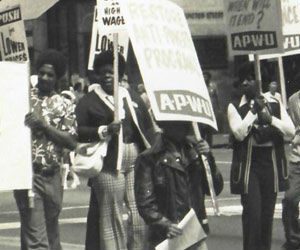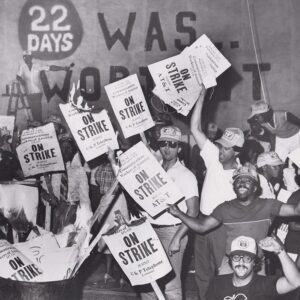April 30, 2014
Ludlow Massacre Forges Mine Workers’ Struggle
(This article appears in the May-June 2014 issue of The American Postal Worker magazine.)
Life was not easy a century ago for coal miners in Southern Colorado, where heavily industrialized mines produced high-grade coal needed by the steel and railway industries.
The largest mining operation in the region, the Colorado Fuel and Iron Company (CF&I), was controlled by oil magnate John D. Rockefeller and railroad baron Jay Gould. The powerful company employed about one in 10 workers in the state, and was notorious for its brutal suppression in 1904 of a strike organized by the United Mine Workers Union. CF&I’s control over the political affairs of Las Animas and Huerfano Counties was “nearly total,” according to A History of the Colorado Coal Field War, a University of Denver online exhibit.

Most of the mines were located in remote canyons, where miners lived in ramshackle “company towns,” and were forced to rent housing, buy food, and purchase goods from their employer. “Doctors, priests, schoolteachers, and law enforcement were all company employees,” the exhibit says, and entry points to the towns were patrolled by company security forces.
Miners were paid in company scrip, and only for the tonnage they shipped. They were not paid for digging the coal, shoring up timbers, laying track, and other tasks, and they were frequently cheated when the coal was weighed.
Coal mining was notoriously unsafe in Colorado, where miners were twice as likely to be killed on the job as in other states. CF&I was able to ignore safety laws because juries hand-picked by local politicians “absolved the coal companies of responsibility almost without exception,” the exhibit notes.
The United Mine Workers (UMW) remained active in the area, despite CF&I’s efforts to infiltrate and disrupt it. But organizing was difficult: Many of the workers were immigrants from Europe and Mexico, and didn’t speak English.
Strike!
But by 1913, the miners were ready to unite.
In September, approximately 90 percent of the workforce – about 12,000 miners and their families – went on strike. Among other demands, they sought: union recognition; enforcement of safety rules; a 10 percent increase in tonnage rates; an eight-hour day, and the right to be paid in cash, trade in any store, and elect their own weightmen. CF&I promptly evicted the strikers, most of whom relocated to tent camps set up by the UMW.

The largest strikers’ camp was adjacent to a railroad depot in Ludlow, CO, used by thee CF&I mines. The union camp was refuge for 1,200 miners and their families, and became a target for CF&I’s most brutal anti-union tactics. To break the strike, the company brought in the notorious Baldwin- Felts Detective Agency. The agency “initiated a campaign of harassment against the strikers,” the University of Denver exhibit says, which included “murders, beatings, and the ‘Death Special,’ an improvised armored car that would periodically spray selected colonies with machine-gunfire.”
CF&I’s strategy was to goad the strikers to retaliate with violence, so the company could demand that Gov. Elias Ammons deploy the state’s National Guard to suppress the workers’ uprising. CF&I got its wish: Armed troops began patrolling the mines and camps in October.
While the state militia was allegedly deployed to protect both sides, it became “little more than a strike-breaking force” under the leadership of its commander, Gen. John Chase, who had suppressed the 1904 strike. Chase essentially declared martial law, jailing strikers without due process; ordering the torture and beating of prisoners, and carrying out daily harassment of families at the camp.
With UMW support, the miners and their families withstood winter in the camps. “It was a time we all stuck together,” said Helen Korich, a Croatian miner’s daughter, who recalled singing union songs at a camp school. “We knew it was right to stand up for our rights.” While segregation was the norm in Colorado company towns, white and African-American miners were welcome in UMW camps.
Men, boys, and girls at the UMW camp for coal miners on strike against CF&I in Ludlow, CO.
The high cost associated with deploying the militia forced the state to withdraw all but two units. But the soldiers who remained were mostly CF&I guards that Chase had enlisted, and they were spoiling for a fight.
The Massacre
At about 9 a.m. on April 20, the militia began spraying the colony with machine gunfire. To draw fire away from the camp, some miners shot back from positions they had taken on the perimeter. The shooting continued all day, while the miners’ families took cover in foxholes under their tents.
At dusk, a passing freight train shielded the camp from the guards’ gunfire, allowing many of the miners and their families to fl ee. With most of the workers gone, the militia moved in to destroy the camp, dousing the tents with kerosene and setting them ablaze.
Huddled in a pit below one tent were four women and 11 young children. Two of the women, Mary Petrucci and Alcarita Pedregone, were able to escape, but their five children suffocated, along with the others who remained trapped by the inferno above.
By the time the smoke cleared, a total of 25 people lay dead, including three militiamen and a passerby.
News of the massacre spread like wildfire to other UMW camps. Thousands of outraged miners and other union members from around the state soon arrived carrying guns. For 10 days the union forces besieged the militia and CF&I’s strike-breaking troops along a 40-mile front from Walsenburg to Trinidad.
The fighting ended when the Gov. Ammons convinced President Woodrow Wilson to send in the U.S. Army to restore peace. The miners held out in the UMW camps for another seven months, but the strike ended in defeat in December 1914 when the fl edgling UMW ran out of money.

In the aftermath, local authorities arrested 332 miners for murder. The trials dragged on until 1920, but the charges were dropped against all but UMW leader John Lawson. His conviction was eventually overturned by the Colorado Supreme Court. Similarly, 22 national guardsmen were court martialed; all were acquitted or given only light reprimands.
Legacy
The Ludlow massacre grabbed worldwide attention and became a rallying cry for workers across the country who sought to organize for fair wages and safe working conditions.
Following the horror of the massacre, the UMW secured some gains in mine safety and labor regulations in Colorado, and a congressional investigation aided efforts to reform employment laws in other states as well. A generation later, in 1935, UMW leader John L. Lewis established the Congress of Industrial Organizations (CIO), which later merged with the American Federation of Labor (AFL).
Today, a granite monument stands where the miners and their family members lost their lives fighting for workers’ freedom and union rights. “The tragic lessons from Ludlow still echo throughout our nation,” said UMWA International President Cecil E. Roberts, “and they must never be forgotten by Americans who truly care about workplace fairness and equality.”
On May 18, as part of a series of commemorative events by Colorado unions, theaters, and public libraries, the UMW will hold a ceremony marking the 100th anniversary of the massacre at the Ludlow Memorial National Historical Landmark. For more information see the Ludlow Centennial page on Facebook.



